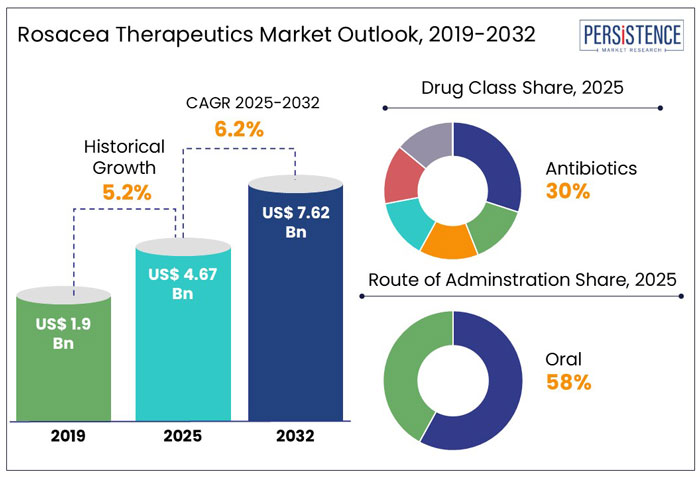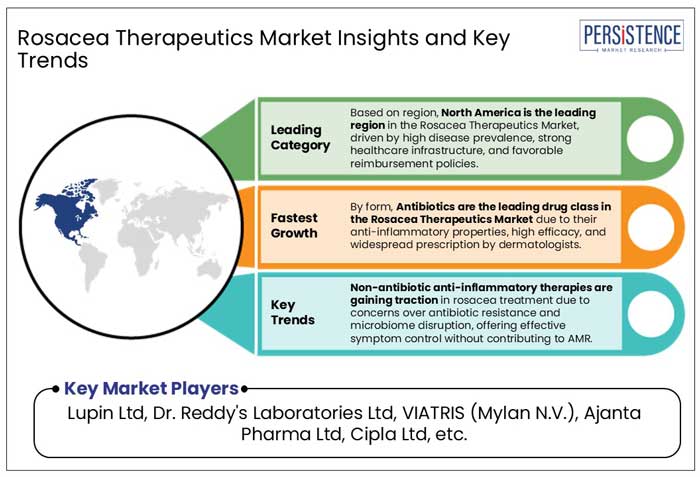ID: PMRREP18793| 386 Pages | 5 Mar 2025 | Format: PDF, Excel, PPT* | Healthcare

The global rosacea therapeutics market size is anticipated to rise from US$ 4.67 Bn in 2025 to US$ 7.62 Bn by 2032. It is projected to witness a CAGR of 6.2% from 2025 to 2032.
Imagine waking up, looking in the mirror, and seeing persistent redness, bumps, and irritation that won’t fade. As per the studies by Persistence Market Research, over 415 million people worldwide, this is a daily struggle, as rosacea affects nearly 5.5% of the global adult population.
With rising rosacea awareness, dermatology consultations have surged by nearly 40% over the past five years. More individuals seek expert guidance, contributing to the growth of prescription-based treatments and medical-grade skincare products.
Beyond traditional medications, researchers are diving into biologics and microbiome-based solutions. Studies suggest that the gut-skin connection is crucial in rosacea, and probiotics could become a game-changer in managing symptoms. This innovative approach is still in its early stages, but the potential for more personalized, effective treatments drives increased investment and research in the field.

Key Highlights of the Rosacea Therapeutics Market
|
Global Market Attributes |
Key Insights |
|
Rosacea Therapeutics Market Size (2025E) |
US$ 4.67 Bn |
|
Market Value Forecast (2032F) |
US$ 7.62 Bn |
|
Projected Growth (CAGR 2025 to 2032) |
6.2% |
|
Historical Market Growth (CAGR 2019 to 2024) |
5.2% |
Surge in Advanced Therapies Aided Market Growth Pre-2024
During the historical period from 2019 to 2023, the market relied heavily on well-known drugs like metronidazole and doxycycline, offering relief but not always long-term solutions.
Dermatologists and patients alike sought innovation, but the pace of progress remained steady rather than transformative. Between 2023 and 2024, the market saw a surge in advanced therapies fueled by rising awareness and demand for more personalized solutions.
The FDA approval of novel treatments, including Emrosi (DFD-29) in 2024, opened doors for more effective oral medications with fewer side effects.
Simultaneously, non-invasive options like Intense Pulsed Light (IPL) therapy and LED light therapy gained traction, providing long-term symptom relief without the drawbacks of pharmaceuticals.
Expanding Medical Spas & Research into Biologics to Propel Growth of the Market
Over the forecast period, the rosacea therapeutics market is expected to witness dramatic growth, driven by increasing dermatology clinic visits, expanding medical spas, and cutting-edge research into biologics and microbiome-based treatments.
The era of generic solutions is fading, making way for a future where rosacea treatment is more tailored, accessible, and effective than ever before. As awareness grows, so does the potential for groundbreaking advancements in this rapidly evolving market.
Growth Drivers
Growing Demand for Aesthetic Dermatology Propels Market
The surge in aesthetic consciousness has significantly influenced the rosacea therapeutics market. In today’s world, where social media and virtual meetings have amplified self-awareness, individuals are more conscious of their skin health and appearance.
Studies show that over 90% of rosacea patients report a negative impact on their self-confidence, driving them to seek treatments that offer both medical relief and cosmetic enhancement.
This demand has spurred the development of combination therapies, where dermatologists integrate skincare, prescription medications, and cosmetic procedures to achieve optimal results.
Pharmaceutical and skincare companies have responded by creating rosacea-friendly skincare products, such as gentle cleansers, anti-inflammatory serums, and mineral-based sunscreens, that complement medical treatments.
The growing trend of medical spas and dermatology clinics offering specialized rosacea treatments has made aesthetic solutions more accessible.
As individuals prioritize clear, healthy skin, the rosacea therapeutics market is experiencing a surge in demand, making aesthetic dermatology a crucial growth driver in its expansion.
Limited Awareness and Misdiagnosis May Hinder Market Growth
Despite growing awareness, rosacea remains an underdiagnosed and often misunderstood condition. Many people mistake it for acne, eczema, or simple skin sensitivity, leading to delayed or incorrect treatments.
The lack of awareness is especially prevalent in Asia Pacific and parts of Latin America, where rosacea is less commonly discussed in mainstream dermatology. General physicians often lack specialized dermatological training, which can result in misdiagnoses and ineffective prescriptions.
Without proper education and awareness campaigns, patients and healthcare providers struggle to recognize the symptoms early, causing unnecessary distress and worsening the condition over time. Until awareness efforts reach a global scale, misdiagnosis and underreporting will continue to restrain market growth, preventing millions from accessing the right treatment at the right time.
The Boom in Medical Spas & Non-Invasive Treatments Spurs Market Demand
Gone are the days when medical treatments and aesthetic care were separate. Today, medical spas (med spas) are blurring the lines between beauty and healthcare, making advanced rosacea treatments more accessible, effective, and convenient.
Treatments like Intense Pulsed Light (IPL), laser therapy, and LED light therapy are gaining popularity for their ability to reduce redness, minimize visible blood vessels, and improve skin texture without downtime or harsh side effects.
A meta-analysis published in 2024 compared PDL and IPL therapies, revealing that IPL had a higher rate of achieving over 75% clearance of rosacea symptoms.
Med spas offer these procedures in a comfortable, patient-friendly environment, encouraging more individuals to seek treatment earlier.
With over 75% of med spas incorporating advanced dermatology treatments, this sector is poised to reshape the rosacea therapeutics market, providing patients with cutting-edge solutions that blend science with skincare.
Drug Class Insights
Antibiotics Lead the Drug Class Segment with 30% of the Total Market Share
Antibiotics took center stage in the market for rosacea therapy, commanding around 30% revenue share and reaffirming their role as the go-to treatment for managing this chronic skin condition.
For countless patients, relief often comes in the form of trusted medications like metronidazole and doxycycline. These medications work diligently to reduce inflammation, control bacterial overgrowth, and soothe the visible redness associated with rosacea.
Dermatologists and healthcare providers favor these medications due to their proven track record, making them a staple in treatment regimens.
As awareness of rosacea grows, more individuals seek medical intervention, leading to a surge in demand for effective therapies. It has strengthened the market presence of antibiotics, ensuring that those struggling with rosacea have access to reliable solutions.
Route of Administration Insights
Oral Route of Administration Leads with 58% of the Share
When it comes to treating rosacea, the oral route of administration has emerged as the leading segment in the rosacea therapeutics market, holding a dominant market share.
Oral method's popularity stems from its ability to provide consistent and systemic relief, especially for patients with moderate to severe forms of rosacea, where topical treatments might fall short.
Oral medications, such as doxycycline and minocycline, are often prescribed to reduce the internal inflammation that exacerbates rosacea. These oral antibiotics tackle the visible redness and address the root cause of bacterial overgrowth.
For many patients, these oral treatments represent a lifeline, offering a more comprehensive approach to managing the condition beyond the surface-level symptoms.

North America Accounts for 36% Of The Global Revenue with a High Prevalence of Rosacea in the Region
North America's dominance is not merely a statistic but a reflection of the region's proactive approach to healthcare.
The high prevalence of rosacea, affecting over 16 million Americans, coupled with a robust healthcare infrastructure, has fostered an environment where pharmaceutical innovations thrive.
This chronic skin condition often leads to significant emotional and social challenges; more than 90% of sufferers report diminished self-esteem, and 41% have avoided social engagements due to their symptoms.
The recent FDA approval of Emrosi (DFD-29) by Journey Medical in November 2024 exemplifies this trend, offering new hope to those battling this chronic skin condition.
Europe owns a Substantial Market Share Due to Cultural Emphasis on Skincare
In the diverse culture of Europe, the rosacea therapeutics market has carved a significant niche, reflecting both the continent's cultural emphasis on skincare and the proactive stance of its healthcare systems.
As of 2023, Europe accounted for a significant market share of the global market for rosacea diagnosis, underscoring its pivotal role in addressing this chronic skin condition.
Studies have illuminated varying prevalence rates across European nations. In Germany, a comprehensive study involving over 161,000 participants revealed a rosacea prevalence of 2.1%, with equal distribution among men and women.
The European market's growth trajectory is further bolstered by the presence of pharmaceutical giants and innovative biotech firms dedicated to dermatological advancements.
Europe's significant share in the rosacea treatment market is a testament to its comprehensive approach, blending robust medical research, strategic industry collaborations, and a deep-seated cultural appreciation for skincare.
Asia Pacific to Hold 19% of the Global Revenue Share with Changing Lifestyles Leading to Rise in Rosacea Cases
The Asia Pacific rosacea therapeutics market is burgeoning, holding around 19% of the global share. Rapid urbanization, changing lifestyles, and environmental factors have contributed to a rise in rosacea cases.
As disposable incomes grow and healthcare access improves, there's a notable shift towards over-the-counter treatments and cosmetic solutions. Nations such as China and Japan are at the helm of this growth, blending traditional skincare practices with modern medical treatments to address the evolving needs of their populations.
The rosacea therapeutics market is witnessing fierce competition as pharmaceutical giants and biotech innovators race to deliver better treatments for this chronic skin condition.
Leading companies in the industry are employing crucial business strategies like mergers and acquisitions, product launches, partnership deals, expansion, and ventures to build a strong portfolio in the market.
As competition intensifies, innovation remains the key battleground, shaping a future where personalized and more effective rosacea treatments become the norm.
Key Industry Developments
Laser treatment is considered to be the most successful treatment for rosacea.
The market is set to reach US$ 4.67 Bn in 2025.
Lupin Ltd., VIATRIS (Mylan N.V.), Ajanta Pharma Ltd., are a few leading players.
The industry is estimated to rise at a CAGR of 6.2% through 2032.
Metronidazole is the most prescribed rosacea medication
|
Report Attributes |
Details |
|
Historical Data/Actuals |
2019 - 2024 |
|
Forecast Period |
2025 - 2032 |
|
Market Analysis Units |
Value: US$ Bn/Mn, Volume: As applicable |
|
Geographical Coverage |
|
|
Segmental Coverage |
|
|
Competitive Analysis |
|
|
Report Highlights |
|
|
Customization and Pricing |
Available upon request |
By Drug Class
By Route of Administration
By Disease Type
By Distribution Channel
By Region
Delivery Timelines
For more information on this report and its delivery timelines please get in touch with our sales team.
About Author